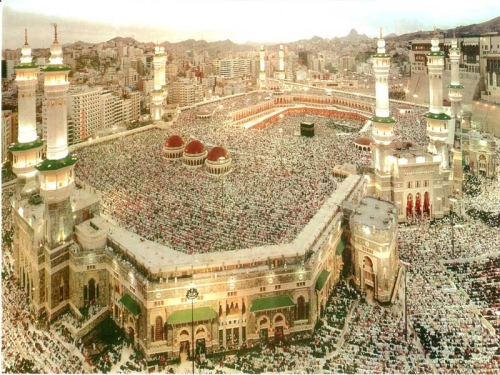Al-Hijr (Madain Salih)
In 2008, the archaeological site of Al-Hijr (Madin Slih) was put on UNESCO’s list of world cultural heritage as the first UNESCO World Heritage property to be inscribed in Saudi Arabia. Formerly known as Hegra, it is the largest conserved site of the civilization of the Nabataeans south of Petra in Jordan. It features well-preserved monumental tombs with decorated facades dating from the 1st century B.C. to the 1st century A.D. The site also features some 50 inscriptions of the pre-Nabataean period and some cave drawings. Al-Hijr bears a unique testimony to Nabataean civilization. With its 111 monumental tombs, 94 of which are decorated, and water wells, the site is an outstanding example of the Nabataeans’ architectural accomplishment and hydraulic expertise.
Mosque in Mecca
As the city of Mecca is the holiest place in the entire Muslim world, Saudi Arabia is no stranger to travelers. For thousands of years, pilgrims have flocked to the country to worship at the Grand Mosque and the Kabaa shrine. The city, in the West of the country, welcomes some two million Muslims a year, who come as part of the Hajj pilgrimage, which makes up one of the five pillars of Islam.
In 2008, the archaeological site of Al-Hijr (Madin Slih) was put on UNESCO’s list of world cultural heritage as the first UNESCO World Heritage property to be inscribed in Saudi Arabia. Formerly known as Hegra, it is the largest conserved site of the civilization of the Nabataeans south of Petra in Jordan. It features well-preserved monumental tombs with decorated facades dating from the 1st century B.C. to the 1st century A.D. The site also features some 50 inscriptions of the pre-Nabataean period and some cave drawings. Al-Hijr bears a unique testimony to Nabataean civilization. With its 111 monumental tombs, 94 of which are decorated, and water wells, the site is an outstanding example of the Nabataeans’ architectural accomplishment and hydraulic expertise.
Mosque in Mecca
As the city of Mecca is the holiest place in the entire Muslim world, Saudi Arabia is no stranger to travelers. For thousands of years, pilgrims have flocked to the country to worship at the Grand Mosque and the Kabaa shrine. The city, in the West of the country, welcomes some two million Muslims a year, who come as part of the Hajj pilgrimage, which makes up one of the five pillars of Islam.

National Museum of Saudi Arabia
The National Museum of Saudi Arabia is another top attraction. It is set in the sweeping grounds of the King Abdul Aziz Historical Area. It provides an extraordinary introduction to all aspects of the kingdom’s natural, religious, historical and social heritage. The museums vast displays draw on various national resources, the most impressive of which is the Riyadh Museum for History and Archaeology. It occupies 28,000 sqm of floor space and consists of eight main display halls which provide an epochal sweep of Arabian history. The museum uses state-of-the-art interactive technology, including small-screen cinemas and audio commentaries in Arabic and English, all of which makes it suitable for both children and adults alike.
Al-Masmak Palace
Al-Masmak was the starting point for King Abdul Aziz to recover the capital of his grandfathers. The palace was renovated and transformed into a public museum. The word “Masmak” means thick, high inaccessible building, and this is applicable to Al-Masmak, which is a strong square fortress with high towers of thick walls. Al-Masmak was used for a long time as arsenal before transformed to museum.
The gate is on the western side of the palace and made of palm date and tamarisk wood. At the middle of the gate there is small door, through which only two persons can pass at a time. The door still bears the mark of the broken spear of King Abdul Aziz when attacking the palace.
The gosque is to the left side when entering the palace. The mosque is a multi pillar room with wall racks for Quran, Miharab and ventilation openings in the ceiling and walls.
The court is opposite the entrance of the palace. It is a rectangular hall with a kitchen for coffee making.
The well is in the northeastern side of the palace. Water was withdrawn with special mechanism installed at the well opening.









![[Weekender] Pet food makers bet big on ‘recession-free’ pet food market](http://res.heraldm.com/phpwas/restmb_idxmake.php?idx=644&simg=/content/image/2024/05/10/20240510050754_0.jpg&u=20240511163252)



![[Weekender] Pet food makers bet big on ‘recession-free’ pet food market](http://res.heraldm.com/phpwas/restmb_idxmake.php?idx=652&simg=/content/image/2024/05/10/20240510050754_0.jpg&u=20240511163252)




![[What to play] Musical tributes to family in the month of family](http://res.heraldm.com/phpwas/restmb_idxmake.php?idx=642&simg=/content/image/2024/05/09/20240509050795_0.jpg&u=)